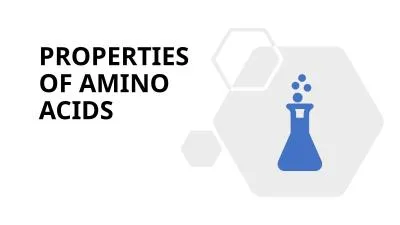

A PHYSICAL PROPERTIES Optical properties All amino acids except glycine possess optical isomers due to the presence of asymmentric carbon atom Some amino acids have a second assymmentric carbon eg isoleucine threonine ID: 914272
Download Presentation The PPT/PDF document "PROPERTIES OF AMINO ACIDS" is the property of its rightful owner. Permission is granted to download and print the materials on this web site for personal, non-commercial use only, and to display it on your personal computer provided you do not modify the materials and that you retain all copyright notices contained in the materials. By downloading content from our website, you accept the terms of this agreement.
Slide1
PROPERTIES OF AMINO ACIDS
Slide2A. PHYSICAL PROPERTIES
Slide3Optical properties: All amino acids except glycine possess optical isomers due to the presence of asymmentric carbon atom. Some amino acids have a second assymmentric carbon e.g. isoleucine, threonine.
Slide4Amino acids as ampholytes : amino acid contains both acidic(-COOH) and basic (-NH2) groups. They can donate a proton or accept a proton , hence amino acids are regarded as ampholytes
Slide5Zwitterion or dipolar ion:
In zwitterions of amino acids with uncharged side chain, the +ve and –ve Charges cancel one another
Amino acids in which the +ve and –ve charges are balanced is at its isoelectric pointThe pH at which this balancing occurs is isoelectric pH
An amino acids is least soluble at its isoelectric pHIncreases solubility at lower pH as well as at higher pH
Slide6EXISTENCE OF AMINO ACID AS CATION, ANION AND ZWITTERION
Slide7Isoelectric pH (symbol pI):
the pH at which a molecule exists as a zwitter ion and carries no net charge making the molecule electrically neutral
Slide8B. CHEMICAL PROPERTIES
Reaction with ammonia
:
The carboxyl group of dicarboxylic amino acids reacts with NH3 to form amideThe amino acid behave as bases and combines with acids (e.g. HCL) to form salts (-NH+3Cl-)
Slide9Reaction with ninhydrin
: The α- amino acids react with ninhydrin to form a purple, blue or pink colour complex (Ruhemann’s purple).
Amino acid + Ninhydrin ------> Keto acid + NH3
+ CO2 + Hydrindantin Hydrindantin + NH3 + Ninhydrin ------> Ruhemann’s purpleNinhydrin’s reaction is effectively used for the quantitative deamination of amino acids and proteins. (Proline gives yellow colour with ninhydrin).
Slide10Colour reactions
Test
Observation
Specific groupBiuretViolet/ purple2 peptide linkageNinhydrinBlue Α-Amino AcidXantoproteicOrangeAromatic amino acidMillon’sRedPhenolic groupHopkins-ColeViolet ringIndole ringSakaguchiIntense redGuanidio groupSulphurBlack precipitate
-SH group
Pauly’s
Red
Imidazole
Folin-ciocalteau’s
-
Phenolic group
Slide11Beta amino acid
β amino acids, which have their amino group bonded to the β carbon rather than the α carbon as in the 20 standard biological amino acids.
The only commonly naturally occurring β amino acid is β-alanine; although it is used as a component of larger bioactive molecules, β-peptides in general do not appear in nature.
Only glycine lacks a β carbon, which means that β-glycine is not possible.
Slide12BETA ALANINEAlso known as 3-aminopropanoic acid,
It is a non-essential amino acid and is the only naturally occurring beta-amino acid.Not to be confused with alanine, beta- alanine is classified as a non- proteinogenic amino acid as it is not used in the building of proteinsβ-Alanine is the rate-limiting precursor of carnosineSupplementation with β-alanine has been shown to increase the concentration of carnosine in muscles
Slide13Amino Acids Polymerize to Form Peptides
Peptides are small condensation products of amino acids.
They are “
small” compared with proteins (Mw < 10 kDa).
Slide14Peptide Ends Are Not the Same
Numbering (and naming) starts from the amino terminus (N-terminal).
AA
1 AA2 AA3 AA4 AA5
Slide15Naming Peptides: Start at the N-terminal
Using full amino acid names:serylglycyltyrosylalanylleucineUsing the three-letter code abbreviation:Ser-Gly-Tyr-Ala-Leu
For longer peptides (like proteins) the one- letter code can be used:SGYAL
Slide16Slide17Slide18Slide19Slide20